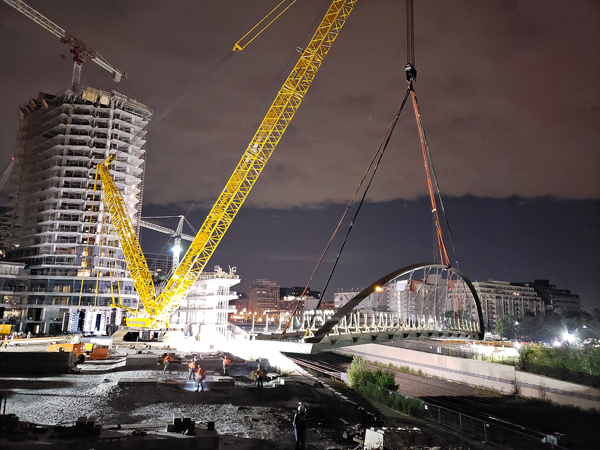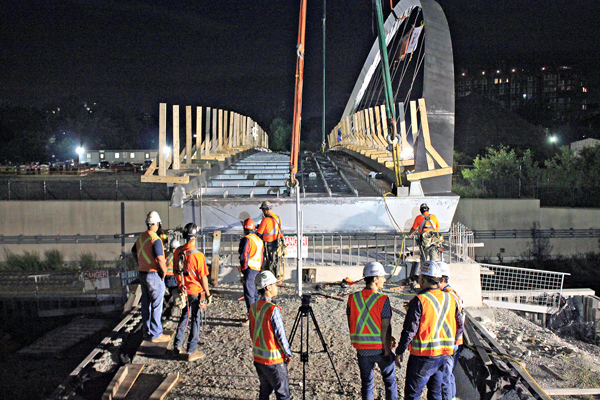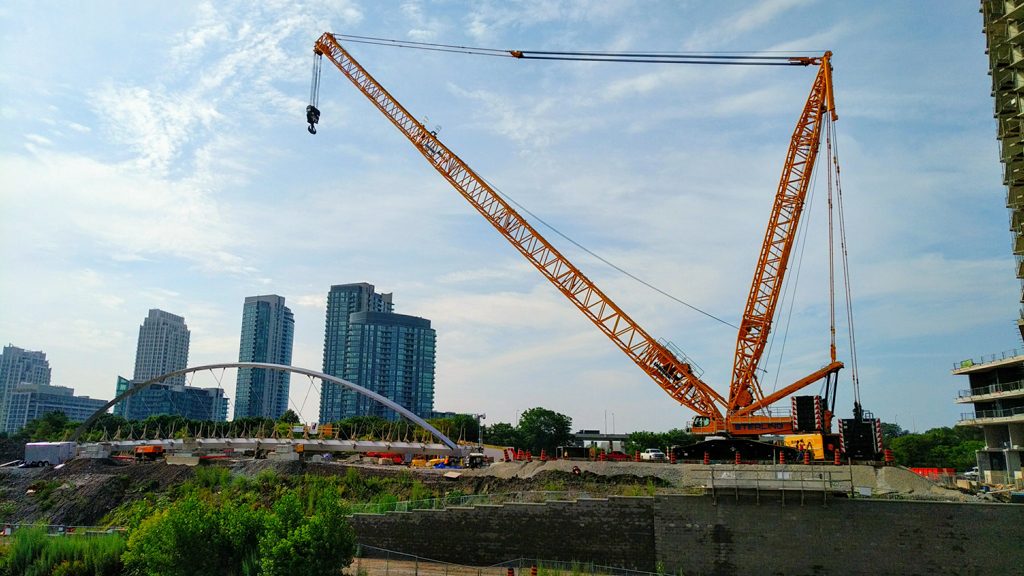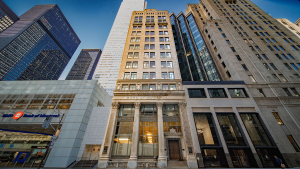The first span of two new bridge crossings over a busy rail corridor in Toronto was installed recently and, once complete, the Garrison Crossing pedestrian and cycle bridge will create a much-needed connection between Trinity Bellwoods Park in the north and the Fort York grounds in the south.
The north span of the new all stainless-steel bridges connecting the South Stanley Park Extension to the Ordnance Triangle was built and installed by Niagara Falls, Ont.-based E.S. Fox Limited and lifted into place July 28.
The bridge is located in the Liberty Village area of Toronto and is bound by two railway tracks to form a triangular shape.
This will be the first 100 per cent stainless steel bridge in Canada, which has many benefits, said Steve Matthews, area manager in the structural steel and bridge division of E.S. Fox Limited.
“A stainless-steel bridge will basically be maintenance free for over 100 years, you don’t have to paint it, it doesn’t rust, there is no repair work to do on it,” he said. “You don’t have to close rail lines down and interfere with trains and traffic to go do maintenance.”
The general contractor on the project is Dufferin Construction and the structural engineer/designer is Pedelta Structural Engineers, a specialty bridge engineering firm based in Spain. The south span of the bridge is expected to be installed in September or October.

“I think they’re trying to link the parks to give it all green access and a route for people to bike and walk,” said Matthews.
The bridge, supplied by Mariani Metal Fabricators, is over 176 feet long and weighs over 300,000 pounds. It was lifted in one piece by one of the largest crawler cranes in North America, supplied by Sterling Crane Canada.
The crane, referred to as a “super-lift,” weighs 725 metric tonnes, has a footprint of roughly 30 metres by 13 metres and can lift 894 metric tonnes. It was built onsite with 32 truckloads of components arriving at Ordnance Street off Strachan Avenue in a “just in time” manner so it wouldn’t interfere with other construction projects or the rail activity in the vicinity, said Matthews.
Planning for the bridge was initiated by the City of Toronto over 10 years ago, but the project was cancelled.
“We originally got the contract to build and install it back then too,” explained Matthews.
“It came back out (more recently) as a design-build contract from the city with a budget cap on it to simplify the design. We ended up getting it again and this time we’re working for a general contractor, Dufferin.
“It was similar to the other one (design) but simplified, lighter and a bit smaller. It’s a leaning arch-style bridge with the rods holding up an orthotropic deck. It’s a nice looking bridge esthetically and pretty unique.”
The bridge was unstable during construction onsite before the lift due to the weight and the length.
“It’s a leaning arch and there is not enough weight on the deck so the way it sits, it’s not stable,” explained Matthews in an interview before the installation.
“We’ve got to build a lot of temporary falsework to hold everything up as we’re constructing everything and have restraints to kind of hold it down because of its shape. Until you get ballast on that deck it’s not a stable structure.”
Because the bridge will be crossing about a dozen rail lines on the north side, arrangements for the rail closure to facilitate the installation had to be made months in advance, explained Matthews.
“To get everybody to close everything was a bit of an undertaking,” admitted Matthews, adding the companies needed to co-ordinate with everyone who uses the rail corridor.
At midnight on July 28 the rail line shut down, leaving an eight-hour window for installation. Crews ran tests last week to ensure they were ready for the actual lift when the rail closure occurred.
“It’s a necessity to do the test pick prior to actually lifting the structure on the rail closure because there isn’t a lot of time,” Matthews explained.

“Basically when the rail closure starts, the bridge will be hanging in the air and as soon as we get the rail line closed the crane will be swinging to get it into place.”
The lift was a success, Matthews reported this past Monday (July 30).
“Everything went really well,” he said. “We used up the whole shut down time but everything got done that was supposed to get done and everyone was pretty happy.”
Once the rail crossing shut down, the crane lifted the entire span up of the bridge and placed it high above the tracks,
“It was hooked in five locations to lift it up — four on the deck and one stabilizing the arch section,” said Matthews.
“It was secured with temporary erection work to the ground and we released that and then put it in place, then hooked up a new set of restraints on the abutment so it didn’t roll and basically installed all the precast concrete panels next. Once the panels go on, that’s basically like the ballast then it doesn’t want to flip over anymore because its heavy enough on the bridge deck section.”
Hand rails will be installed and a non-slip coating will placed on the concrete panels to complete the bridge.











Recent Comments